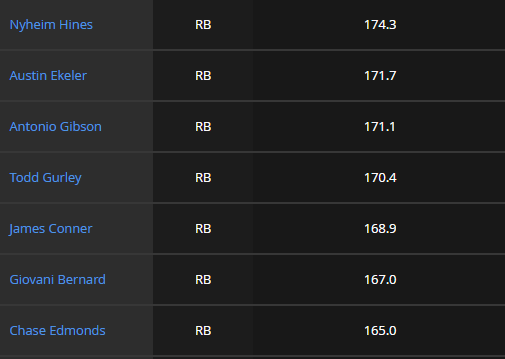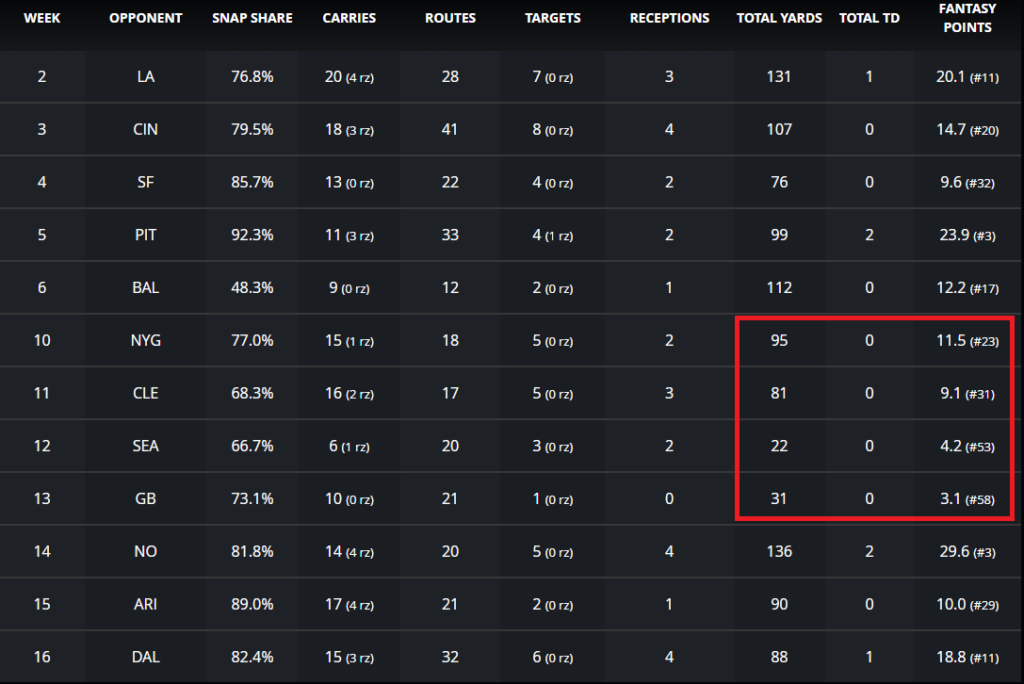
Miles Sanders finished his rookie season in 2019 with over 1,300 yards from scrimmage and displayed impressive efficiency in the process. He averaged 5.8 (No. 7 among qualified running backs) Yards Per Touch, 1.51 (No. 24) Yards Created Per Touch, and had a 32.8-percent (No. 5) Juke Rate. From Weeks 11 to 16, he finished with under a 65.0-percent Opportunity Share in only one game and had three top-10 weeks from Weeks 13-16. The hype for Sanders led to a late first-early second-round price tag in non-Superflex drafts last season.
Fantasy analysts, myself included, were high on Sanders entering 2020 but were ultimately disappointed by his 13.9 (No. 18) Fantasy Points Per Game average last season. However, it’s possible that the breakout that analysts predicted for Sanders is on the horizon and that we were a year early. An elite fantasy football season is a combination of opportunity, productivity, talent, and luck. Here’s why Sanders is the 2020 2021 breakout running back.
OPPORTUNITY
Opportunity is the key to scoring points in fantasy football. PlayerProfiler utilizes an excellent advanced stat, Weighted Opportunities, created by Scott Barrett. Weighted Opportunities “discount carries and enhances the value of targets”. In PPR leagues, Barrett states that a target is worth 2.83 times as much as a carry.
When comparing the top-12 running backs in PPR fantasy points per game in 2020, 10 of the 12 running backs finished top-12 in Weighted Opportunities Per Game. This trend continues back to 2018 when Weighted Opportunities was initially calculated. In 2019, 10 of the top-12 running backs in Weighted Opportunities finished top-12 in Fantasy Points Per Game. In 2018, all top-12 running backs in Weighted Opportunities finished top-12 in Fantasy Points Per Game.
Did you know that Sanders averaged 15.0 (No. 13) Weighted Opportunities Per Game last season? It’s funny how Underdog drafters continue to fade him in drafts (ADP: 43.4, -5.93 trend). Clyde Edwards-Helaire, who also averaged 15.0 Weighted Opportunities Per Game, has an Underdog ADP of 22.7 (-0.3 trend). Sanders is a three-down running back, evidenced by his 77.0-percent (No. 3) Snap Share; eight of the top-12 running backs in Snap Share finished top-12 in Fantasy Points Per Game. At his floor and current Underdog ADP trend, Sanders is shaping up to be the best fourth-round pick in 2021 redraft leagues.
Yes, the Eagles added running backs to their team this offseason. Kerryon Johnson and Jordan Howard are fantasy football non-factors. Howard averaged an abysmal 0.36 Yards Created Per Touch and 11.1-percent Juke Rate. By the end of the season, Johnson saw minimal action with the Detroit Lions. He was relegated to the bench by residential NFL dinosaur, Adrian Peterson. Kenny Gainwell, and his 13.8-percent (91st-percentile) College Target Share, has been pigeonholed into the Nyheim Hines role in the Nick Sirianni offense.

It is premature to expect a fifth-round rookie to see the opportunities that Hines received last year with Sirianni. Remember, Hines saw 174.3 (No. 19) Weighted Opportunities last season. In fantasy football, are we seriously expecting Gainwell to see Weighted Opportunities that rivals what Antonio Gibson saw his rookie season (171.1, No. 21)? Gainwell, Johnson, and Howard are competing for backup roles with incumbent Boston Scott to spell Sanders, but Sanders remains the featured back of the offense.
PRODUCTIVITY
All of the top-12 running backs in Fantasy Points Per Game also finished top-12 in Yards From Scrimmage Per Game. Derrick Henry and Dalvin Cook were achieved their yards primarily on the ground, averaging over 100 yards per game. Alvin Kamara, Christian McCaffrey, and Austin Ekeler all averaged over 40 receiving yards per game. These three running backs also averaged over 5 receptions per game.
Miles Sanders is unlikely to achieve these receiving milestones, but he averaged 72.6 (No. 8) rushing yards per game and that matters. Nine of the top-12 2020 running backs in rushing yards per game finished top-12 in Fantasy Points Per Game. For comparison, only five of the top-12 running backs in receiving yards per game finished top-12 in Fantasy Points Per Game.
It’s also not like Sanders is a non-factor in the passing game either. Yes he had eight (No. 2) Drops in 2020. It doesn’t matter. In 2019, Chase Edmonds (19.0-percent), Myles Gaskin (16.7-percent), and Dalvin Cook (12.7-percent) had similar Drop Rates compared to Sanders’ 2020 campaign (15.4-percent). The following season, those three running backs saw their drop rates improve to under 9.0-percent. Even Sanders saw his Drop Rate change drastically from 3.2-percent on 63 (No. 13) targets in 2019. It’s more probable that Sanders’ 2021 Drop Rate falls between his 2019 and 2020 Drop Rates then it mirroring his 2020 rate.
The drops don’t matter, but what does matter is his 62.9-percent (No. 4) Route Participation and 12.3-percent (No. 13) Target Share. Sanders showed in his rookie season that he is a capable receiver and his utilization in the passing game will continue.
TALENT
Miles Sanders’ talent is a combination of his running ability, receiving ability, and his athleticism. Sanders, a 5-11, 211-pound running back with a 120.3 (76th-percentile) SPARQ-x Score and a 8.4-percent (68th-percentile) College Target Share, has proven to translate his collegiate metrics to the NFL. Don’t forget the company Sanders joined in 2019!
Despite playing behind an offensive line ravaged by injuries, Sanders had impressive efficiency metrics. Sanders averaged 4.7 (No. 11) True YPC and shook defenders with his 24.0-percent (No. 20) Juke Rate. Sanders’ offensive line managed an 86.4 (No. 17) Run Blocking Efficiency rating, and Sanders complemented it with his 1.67 (No. 10) Yards Created Per Touch.
He’s now a flawless talent though. Sanders saw 6.7 (No. 46) Average Defenders In The Box, which on average was less than a base front. When Sanders face a stacked front, he only averaged 2.0 YPC. Carson Wentz’ 57.2-percent (No. 35) Play-Action Completion Percentage led to Sanders struggling when Wentz lined up under center. When Sanders took a carry from Wentz under center, he averaged 3.4 YPC. For comparison, Lamical Perine averaged 3.5 YPC in the same formation.
Where Sanders does excel is taking carries out of shotgun formation. Only TWO running backs in 2020 averaged 6.0 YPC out of shotgun while seeing a 70.0-percent Shotgun Carry Rate: J.K. Dobbins and Miles Sanders. This is excellent news for Sanders’ 2021 outlook. I covered this over on PlayerProfiler. When Jalen Hurts took over as the starting quarterback, the Eagles ran most of their plays out of shotgun formation. When Hurts and Sanders started for the Eagles (Weeks 14-16), only the Ravens (95.0-percent) and Dolphins (94.0-percent) ran more plays out of shotgun than the Eagles (90.0-percent) according to SharpFootballStats.com.
LUCK
Luck cannot be quantified nor predicted, but is necessary for a running back to have a breakout season Last season’s example would be James Robinson. The release of Leonard Fournette created a wide open depth chart that Robinson seized control of, and he remained healthy for the entire season. Another example is David Montgomery. An unfortunate ACL tear for Tarik Cohen and a cakewalk schedule at the end of the season allowed Montgomery to finish in the top-12 in Fantasy Points Per Game. For Miles Sanders, luck was not on his side in 2020.

It started before the season did; Sanders dealt with a lower-body injury that limited him in the offseason and kept him out of Week 1. This would be an ominous sign of what his 2020 season would become. He suffer a knee injury in Week 6 and miss the following two games. He returned in Week 10 to his full-time role, but was affected by his injury. He had his three worst fantasy performances in Weeks 11-13, failing to score 10 fantasy points in any of the three games.
Through Week 13, Sanders scored three total touchdowns as the Eagles’ offense finished second-worst in the percentage of drives ending in a score per ProFootballReference.com. The Carson Wentz-led offense also finished with the second-highest percentage of drives ending in a turnover. When your offense is as bad as the Eagles were last season, you’re not going to have a breakout season. The Eagles, finished with the Wentz project, had a changing of the guard at quarterback and gave us a taste of what Sanders would look like in 2021.
Sanders ended the season strong with two top-12 performances in his final three games after Jalen Hurts took over at quarterback, including a season-best 29.6 fantasy point performance against the top fantasy defense against running backs (Saints). It is a small sample size, but it’s clear that the move away from Wentz opens the door for Sanders to put together the four pieces of the puzzle for a breakout 2021 season.
RECAP
Because Miles Sanders was drafted in the first round last year, people are having a hard time trusting him in 2021. But the hate has gone too far. He still checks the boxes when it comes to opportunity, productivity, and talent. Luck was not on his side last season as he dealt with injuries and a turnover-prone offense lead by Carson Wentz for the majority of the season.
It seems this offseason people are creating narratives on why to fade Sanders. Jalen Hurts is GOOD for Sanders’ 2021 fantasy outlook. An offense playing out of shotgun formation is beneficial to Sanders’ game. A rookie running back in the fifth round and two veteran running backs clinging on to NFL roles are not serious threats to Sanders’ opportunities. We hate ADPs, not players. Sanders is a steal at his current price and is positioned to be 2021’s breakout running back.
